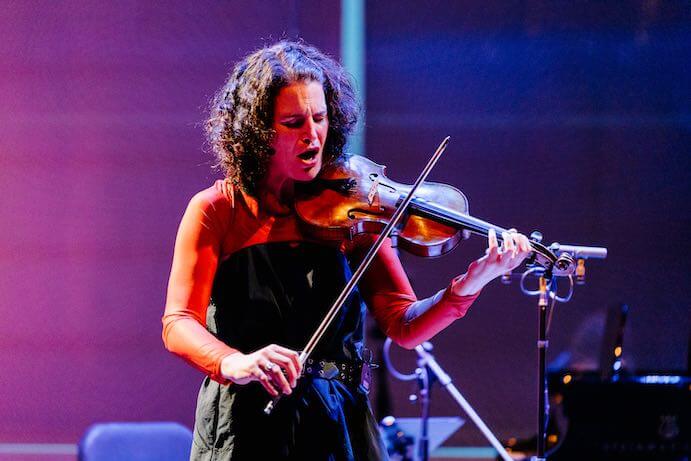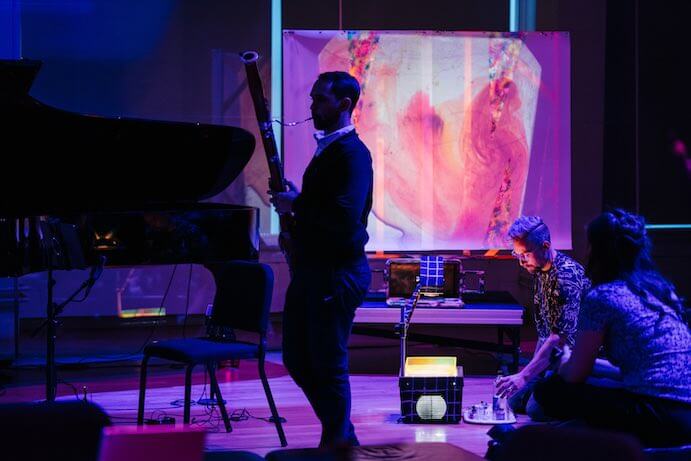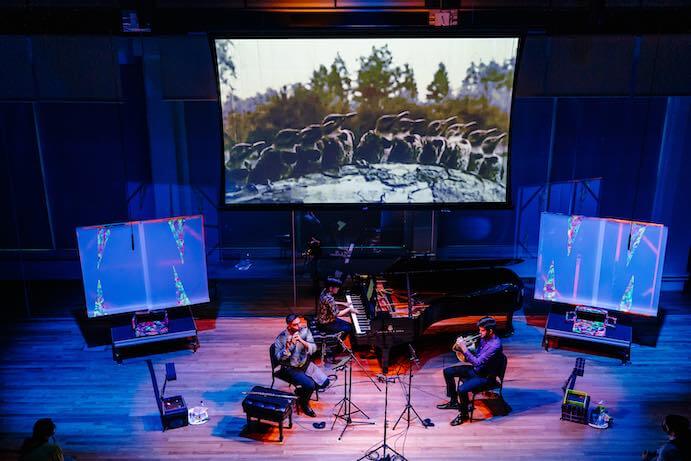Carnegie Hall isn’t just piano prodigies and Lenny Bruce. Over the years, Carnegie has continued to expand beyond its famous Midtown walls through partnerships with organizations like Detroit’s Sphinx Organization or NYC Department of Education schools. In 2014, it also completed the four-year construction of the Resnick Education Wing, which houses Ensemble Connect as part of its education program. In addition to offering performing opportunities and mentorship, Ensemble Connect partners with 15 NYC public schools and individual instrumental music teachers and gives approximately 60 school performances each year. Open to all postgraduate musicians, the two-year ensemble fellowship aims to develop new forms of audience participation, and this was one of several triumphs at their June 6, 2022 concert, “Ensemble Connect Up Close: Ripple Effect.” Presented in collaboration with Artistic Partner The Afield (the multidisciplinary duo of visual artist and writer Anthony Hawley and violinist Rebecca Fischer), the evening was a colorful reminder that nature, technology, and humans can intertwine for the better.

The Resnick Wing’s entrance gallery featured original pieces by Anthony Hawley that corresponded to the performance space art installation. Three large spray paint drawings on Dura-lar film hung in Eric Southern’s spectacular lighting design, augmenting Hawley’s neon color palette that was inspired by underwater phosphorescence and emergency workers’ garb. (Carnegie Hall’s security team was an effective and pleasant presence, informed about the event and socially active in the gallery.)
The concert was indeed “Up Close:” Audience members could sit in a semicircle of chairs around the periphery or on benches in the center. Two decorated projection screens framed the piano, and to open the program, Hawley transformed two analog projectors into a live-animation installation by placing trays of water over the glass platens and mixing in dyes and bits of plastic printed with poetry. As Hawley created the projections, Rebecca Fischer ambled through the hall reading the poetry aloud and playing her violin. This predominantly visual movement, the first of three Oscillations which loosely structured the program, transitioned seamlessly into Mary Jane Leach’s surprisingly peaceful piece Feu de Joie for Nik Hooks‘ solo bassoon and six pre-recorded bassoons.

Glitch, the inimitable Nina Shekhar’s joyous and goofy piece inspired by record skips and uneven playback, was the first of several exquisite chamber performances from the nine ensemble fellows. None of the sonic works were particularly angular or dissonant; the music leaned away from abstraction and offered lush timbres with occasional grooves.
Two pieces were paired with original films by Hawley: Angélica Negrón’s Cosmorama for violin, french horn, piano, and fixed electronics functioned as a film score and lent a spacious grandeur to images of planets intercut with abstract shapes. However, for Lisa Bielawa’s Fictional Migrations, the pastoral film seemed only to illuminate the music, allowing Amir Farsi’s virtuosic and birdlike flute playing to shine while Bielawa’s writing for piano and horn constructed something big enough for all the world’s bird migrations; the volume of the flute and piccolo in high registers was uncomfortable at close range and the work needs a bigger space. In both these works, Cort Roberts’ plush and regal horn evoked cosmic grandeur and Sir David Attenborough’s narrative presence. Pianist Joanne Kang avoided the shallow angularities that plague so many interpretations of contemporary works, instead calibrating a distinct and resonant sound to each composer.

The event’s gently theatrical flair was offset by its upbeat tone and flawless technical execution. Southern’s light design played a critical role in creating an unbroken immersive experience. Well-timed fades prevented clapping in between pieces — except after Aida Shirazi’s Blood Moon, when the audience couldn’t help itself and applauded for the unabashedly cinematic piece with its howling wolf imitations and an ensemble bathed in red light.
And by the end of the night, the audience was performing, too. In Oscillation (III), Fischer transformed the audience into a singing drone accompaniment for her violin, and the final piece of the program demanded audience participation the entire time as Hawley emceed the instructions of Negrón’s Make a Sound (World Premiere).
Make a sound.
Make your neighbor’s sound.
Make your mother’s sound.
Make a sound with your fists.
Make a sound with your toes.
Make any sound…
The room echoed with hoots, barks, and laughter — and applause.
I CARE IF YOU LISTEN is an editorially-independent program of the American Composers Forum, funded with generous donor and institutional support. Opinions expressed are solely those of the author and may not represent the views of ICIYL or ACF.
A gift to ACF helps support the work of ICIYL. For more on ACF, visit the “At ACF” section or composersforum.org.
























